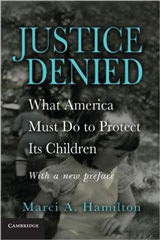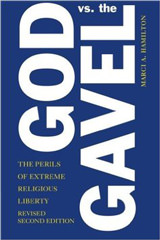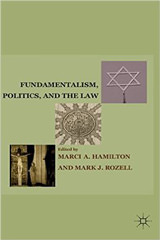Our national guru of vaccination, Dr. Anthony Fauci, recently stated that he did not anticipate needing or endorsing a mandate to be vaccinated once a COVID-19 vaccine is ready. He stated: “They have the right to refuse a vaccine. I don’t think you need a contingency plan. If someone refuses the vaccine in the general public, then there’s nothing you can do about that. You cannot force someone to take a vaccine.” Fauci’s reasoning did not illustrate a full understanding of either the constitutional or statutory issues involved.
There is no constitutional right to refuse a government mandate needed to prevent the deaths of fellow Americans. The Supreme Court has routinely upheld vaccine mandates against constitutional attack starting with Jacobson v. Massachusetts, so the issue is not the Constitution standing in the way of a vaccine mandate. The First Amendment simply does not provide a pathway to successfully object to a neutral, generally applicable vaccine mandate against a pandemic.
The real threat to herd immunity, however, lies in the statutory religious liberty statutes and exemptions, which we need to address sooner rather than later. They are a potential escape hatch for religious and nonreligious objectors.
Some reporting indicates that the anti-vaxxer, or vaccine hesitant, movement is growing, because there are fears that the COVID-19 vaccine is being rushed and undertested. President Trump just added fuel to that fire when he used his executive authority to push availability of convalescent plasma before it is subjected to randomized trials. As Dr. Paul Offit says, this looks a lot like political bullying overtaking the science.
Until there is a safe and effective vaccine—based on the best science—that is endorsed by the leading infectious disease experts like Dr. Fauci and Dr. Offit, everyone should have the right to sit on the sidelines. We have a right to “life” in the Constitution that demands accountability from scientists and industry delivering a COVID-19 vaccine to the public. But once the scientific barriers have been scaled, there is no question that we need to follow their science-based recommendations,
Now is the time to consider what barriers other than science stand in the way of herd immunity against this pandemic. The short answer is that the law stands in the way. Religious liberty statutes and religious/philosophical exemptions to state vaccine requirements create a potential escape hatch for those who deny the science.
This is not our first rodeo with a vaccine against a deadly disease, of course. A readable, scientifically sound history of vaccines and the man behind eight of the current fourteen childhood vaccines, Maurice Hilleman, is documented in Dr. Offit’s book, Vaccinated: One Man’s Quest to Defeat the World’s Deadliest Diseases. It should be mandatory reading for all elected officials. Today, smallpox is history, and the fourteen diseases against which children should be inoculated, have been defanged to the point that many parents have no idea how deadly and disabling they can be.
We also know that states without exemptions to childhood vaccine requirements have lower contagious disease rates. That’s right: vaccine mandates increase public health. We need to pay attention to that evidence-based conclusion if we expect to elude this coronavirus.
How the United States Became a Country Where Religious Liberty Could Be Complicit in Greater Suffering During a Pandemic
In 1997, I won a case at the United States Supreme Court against the law school establishment and every mainstream religious organization in the United States. It was an improbable win. I was a female, junior faculty member at Cardozo School of Law, Yeshiva University, up against the leading law school academic in the United States on religious liberty, Prof. Douglas Laycock, of the University of Texas Law School. True, I had clerked at the Supreme Court for Justice Sandra Day O’Connor, and he hadn’t earned that honor, but I was an untested woman arguing against the received wisdom of the law professors. Shortly before the argument, Laycock’s law school dean told the media I didn’t have a chance.
In their small defense, this was, after all, the first case I’d ever had, at any level. All the betting was against me and the little City of Boerne, Texas (and its Methodist mayor, the Rev. Patrick Heath); the law professor listserv unanimously agreed that Laycock had to win. They even placed bets. One solo professor took the contrary bet out of pity for me I suppose. Good choice, Michael Stokes Paulsen.
We won. In Boerne v. Flores, , the most extreme religious liberty law in the history of the United States—the Religious Freedom Restoration Act of 1993—was held unconstitutional every way to Sunday. Not a single member of the Court praised or defended the law at the oral argument or in the opinions. RFRA, pronounced “riff-ra,” was the product of law professors who lived in an ivory tower of ignorance about the harm religion can inflict, or who simply didn’t care about that harm. RFRA was a searing attack against the rule of law; it was intended to blunt the effect of every law against every single layer and element of government in the United States, local, state, and federal, legislative, judicial, and executive—to benefit believers to the detriment of whoever that law was supposed to protect.
The religious lobbyists almost immediately returned to Congress to demand a RFRA redux. After defeating RFRA, every interest in the United States that fights corrupt and harmful religious actors contacted me from children’s rights organizations to state Attorneys General. The law schools’ makeup at the time meant that law professors were predominantly pro-religion (as I had been!). I was educated after the Boerne decision came down by those like Rita Swan, founder of Children’s Healthcare Is a Legal Duty, who lost her young son to an easily treated infectious disease as a member of the Church of Christ Scientist and then turned her entire life to saving children from such needless deaths. I learned things I didn’t want to know, frankly, and started a folder euphemistically labeled “Religion Misbehaving.” As a believer myself, I was appalled at the cruel and dangerous acts of the religious. But I was also now alarmed that this law that gives carte blanche to believers to selfishly harm others was under reconsideration in Congress.
I testified. I said that it was unconstitutional. A Democrat pulled me aside to tell me they all knew it was unconstitutional, but politically they had to consider it. He told me it was going nowhere. When it became crystal clear to me that members of Congress honestly didn’t care about the constitutional arguments or the Supreme Court’s reasoning in Boerne, I switched tack to gather examples of how RFRA would undermine the rule of law and harm the vulnerable. At the time, it was a “list of horribles.” These were at the top of my list of the vulnerable: children, women, people of color, the disabled, and LGBTQ. I predicted re-enactment of RFRA would undermine civil rights and vaccination mandates.
At the same time, I reached out to the organizations that I felt compelled to alert, because they weren’t aware that their interests were on the chopping block. Let’s just say that I struggled to get through to them, and a few, like the National Organization of Women, even hung up on me! No one wanted to believe that religious liberty could have as dark a side as I was painting. Well, I didn’t either, but facts are facts.
RFRA was re-enacted in 2000, and it has indeed undermined civil rights, because both parties failed to stand up for the vulnerable against the powerful religious lobbies. The truth is that Democrats are the reason that Congress enacted a new RFRA in 2000. The bill was dead, and all they had to do was walk away, but then they blinked. Some members of Congress feared that Title VII was at risk, but they could not resist the siren’s song of collective religious lobbying. As I pointed out in my 1998 testimony, “Framer Rufus King, one of the youngest members of the Constitutional Convention but a Harvard graduate who was highly respected on structural issues, [said]: ‘[I]f the clergy combine, they will have their influence on government.’”
The 2000 RFRA passed via unanimous consent, which means few members were there and no votes were recorded, on July 27, 2000. President William Clinton signed it, just as he enthusiastically and foolishly signed the RFRA of 1993. Twenty years later, we are about to see the role RFRA plays in the midst of a pandemic threatening the lives of Americans.
If You Want an Effective Vaccine, Amend RFRA
RFRA could be a major barrier to obtaining herd immunity through an effective vaccine. We know that it is already a potent weapon against public health. It was deployed by a for-profit arts and crafts store in Burwell v. Hobby Lobby, and an elderly care religious order in Little Sisters of the Poor v. Pennsylvania, to avoid providing cost-free contraception to female employees—despite the clear public health evidence that contraception increases women’s health, achievement, and longevity.
RFRA was recently described by Justice Neil Gorsuch as a “super statute” in Bostock v. Clayton County. If “super” means omnipresent, it sure is. RFRA modifies every federal law, whether executive, legislative, or judicial to the benefit of the person, organization, or corporation invoking a religious belief that conflicts with a law.
Here is the script that threatens public health by opening wide the door to avoid a safe and effective COVID-19 vaccination: Say the Administration issues a nationwide COVID-19 vaccine mandate. The person or organization that opposes vaccination would have to prove that the mandate imposes a “substantial burden” on their beliefs. At one time, that prerequisite had bite, meaning the believer had to prove a substantial burden, but the second enactment of RFRA in 2000 added language that watered it down and then the Hobby Lobby decision turned “substantial” in the phrase “substantial burden” into “de minimis” and even “imaginary.” Remember that Hobby Lobby’s religious liberty argument was that it needed RFRA to protect it from having to pay for abortifacient contraceptives to female employees, but the contraceptives they rejected were not in fact abortifacients; they just believed they were. Under this reasoning, when an anti-vaxxer asserts that the vaccine will cause bodily harm—despite strong evidence in the science that is not true—RFRA and Hobby Lobby create a disturbing matrix of reasoning that favors the anti-vaxxer.
The Hobby Lobby decision also cast in doubt how robustly federal courts can question the sincerity of religious liberty claims, so expect innovative religious claims from anti-vaxxers against the COVID-19 vaccine, whether or not their objection is religious.
Once the individual has proven a “substantial burden,” the burden shifts to the government to prove the mandate serves a “compelling interest.” Ok, I think we can all agree that preventing widespread illness and death and fully and safely reopening the economy and schools serve compelling interests of the highest order.
But then comes the problem with RFRA in virtually every case: the government must also prove that the mandate is the “least restrictive means” possible for this believer for the government to achieve the compelling interest. What is the “least restrictive means” of enforcing a vaccine mandate? Now the courts get into the business of second-guessing the experts, and imaginatively come up with ways for the believer to avoid the law. Let’s put on our thinking caps: what is “less restrictive” to the anti-vaxxer than getting the vaccine? They could promise to wear a mask everywhere they go for the rest of their lives, or that they will stay home forever, both of which are unenforceable. It is always “least restrictive” not to enforce the law that RFRA is hobbling. RFRA swings the door wide for the believer and, frankly, insincere nonbeliever as well, and during a pandemic that would mean herd immunity becomes elusive.
RFRA’s proponents will say that in the case of a pandemic that “of course” RFRA won’t be a threat. If that is their position—that proper interpretation means no barrier to a vaccine mandate for a safe and effective vaccine—then they should agree to an exemption now. Besides, that is what they said about RFRA and Title VII in 2000 when RFRA was re-enacted. Supposedly RFRA would never be a real threat to real civil rights. RFRA and RFRA redux have always been presented to lawmakers as apple pie and the American dream in one attractive package. Of course, RFRA rolled right over Title VII in the context of female employee rights against discrimination in their benefit packages in the Hobby Lobby and Little Sisters of the Poor cases. The Supreme Court’s latest interpretation of Title VII in Bostock, which expanded Title VII’s coverage to LGBTQ is where Justice Gorsuch said RFRA is a “super statute.” There was much celebration that a conservative justice had sided with LGBTQ, but he only did so with a RFRA roadmap charting an avenue to discriminate against LGBTQ, as I discussed here. Let’s just amend RFRA now so that it cannot be invoked against a safe and effective vaccine.
The States Also Have Statutory Barriers That Need to Be Cleared
In the event the Administration does not issue a national vaccine mandate, or argues that such a mandate must come from the individual states, there are also serious state legislative barriers to achieving herd immunity. Roughly half of the states have a statute patterned on the federal RFRA that creates “super rights” against any state law. These state RFRAs need to be amended—just as the federal RFRA does—to ensure there is a pathway to herd immunity. These amendments take care of the problem of adults avoiding the duty to vaccinate against COVID-19. Then there are the kids.
There are many states that would provide a wide swath for children to avoid immunization. I can see why parents would have reservations against giving the first wave of vaccines to children. No vaccine testing now is being performed on children under age 18, but they aren’t going to be in the first wave of those receiving vaccines to start anyway. Again, the proper threshold has to be: is the vaccine safe and effective for children?
Once there is a safe and effective vaccine for children, which has been tested on children, and the medical experts have endorsed it, the COVID-19 vaccine will need to be added to the list of vaccinations required before kids can start school each fall. Yet, many states have religious and even philosophical exemptions to childhood vaccine requirements that will undermine herd immunity. Only five states create a clear path to a vaccine mandate for children: California, Maine, Mississippi, New York, and West Virginia. An alarming 30 states have religious exemptions, and half of those states extend that exemption to include philosophical objections, as think tank CHILD USA documents here. This checkerboard of exemptions would doom the vaccine’s ultimate effectiveness. Therefore, the state children’s vaccine exemptions need to be prophylactically amended to eliminate a religious or philosophical exemption for a safe and effective pandemic vaccine.
When I predicted in 1998 that RFRA would pose barriers to vaccine mandates and civil rights, I thought our elected representatives would see its dangers and leave it in the dustheap of history. They didn’t. Now we must deal with RFRA’s proven threat to public health in the midst of a pandemic.









